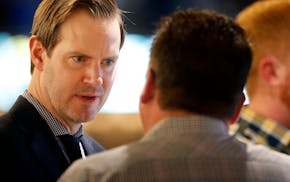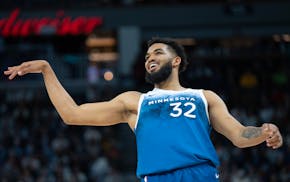The wide, wide world of sports wasn't all that wide in the fall of 1959, particularly here in the Twin Cities. There was one major league team, the Minneapolis Lakers, and they were an endangered franchise in an eight-team NBA.
There were also eight official weight classes in professional boxing, and one organization to certify eight world champions. The sporting public knew all of their names, except maybe the flyweights from a foreign land.
There was no comparison in the public following for these activities: Big fights were far more popular than pro basketball, to the point promoters started to make deals to show the fights on closed-circuit TV outlets — theaters, arenas — around the country.
Bob Short led a group that purchased the Lakers in 1957. The team was regularly bounced from the Minneapolis Auditorium due to other bookings, so Short made the Minneapolis Armory, until then an alternate site, the city's home court before the 1959 season.
Les Sellnow is the author of a book on the history of the Upper Midwest Golden Gloves. As with the Lakers, the Upper Midwest tournament — a large and well-publicized event well into the 1960s — would wind up in the Armory when the Auditorium was booked.
"The Armory was never the first choice,'' Sellnow said. "It was a building intended to store military vehicles and supplies. As a sports arena, it was a big, drafty, cold building with about two bathrooms.''
Short made a show of trying to sell the Armory to the public as the new home of the Lakers, even though his heart and bank account were already two-thirds of the way to Los Angeles.
On Oct. 14, an Armory with a few bucks in improvements held the "Sports Spectacular'' — a doubleheader of NBA exhibitions, with the Lakers and Detroit in the first game, and the Philadelphia Warriors vs. Boston in the second game.
The hook was that Warriors rookie Wilt Chamberlain and Boston's already dominant defender, Bill Russell, would be meeting for the first time.
Quite a hook, right? Not really. Short also had to bring in Ingemar Johansson, the newly crowned world heavyweight champion, after his knockout of Floyd Patterson on June 26, 1959, for a special appearance.
Short must have figured that's what it would take to get the Swedish population in Minneapolis — a heavyweight champ from the homeland — to sell a spectacular number of tickets. Johansson made a few public appearances in Minneapolis and was introduced to the basketball crowd at the Armory, which was announced as an unimpressive 3,200.
The Minneapolis newspapers gave 10 times more pub to Ingemar being in town for a couple of days than the first Wilt-Russell matchup.
That included Barbara Flanagan's piece across the top of the Tribune's front page on Oct. 15, which had this lead sentence: "Ingemar Johansson is a double-helping of Swedish smorgasbord with shy blue eyes and dimple on his chin.''
Hey, it was 1959, and there weren't Vikings, Twins, Timberwolves, Wild-ings, Loons, and certainly not Lynx in those pre-Title IX days. We had Gophers football, the state basketball tournament, and a ho-hum attitude about an NBA team that would head off to Los Angeles after that season.
And we had boxing, a king among sports from the time the Armory opened in 1936. For example:
• Henry Armstrong, the only three-division champion in the days of eight weight classes, knocked out Charlie Burns in the second round on April 30, 1938, three days after he knocked out another fighter in Chicago.
• Fritzie Zivic drew a crowd of 9,000 in beating Dick Demaray, a regional favorite from North Dakota, on April 4, 1941. Demaray was stopped with a severe cut, but not before delivering a punch that Zivic said was "the hardest I've been hit as a champion.''
• Sugar Ray Robinson, the greatest fighter of all in the opinion of many, stopped Dick Banner in the second round on April 30, 1942. It was the only pro fight for Banner, a National Golden Gloves champion.
There was also an Armory appearance by Rocky Marciano as a referee at a Golden Gloves event, and Sugar Ray Leonard held an amateur tournament there years later.
Through it all, the Armory remained big, drafty and cold and eventually became a parking lot.
And now it is none of those things.
Ned Abdul, an under-the-radar redeveloper of downtown buildings, has turned the Armory into an impressive combination of the historic and the new. And, get this, there's no public money involved.
There already have been successful concerts, starting with Super Bowl week, and on Friday night, there will be a professional boxing card in the Armory for the first time since September 1973.
Jamal James, rangy welterweight, 22-1 record, big personality with the nickname "Shango,'' will meet Abel Ramos in the main event. The Premier Boxing Champions telecast on FS1 should be an excellent showcase for James; for certain, it will be an excellent showcase for the Armory as a boxing venue.
Tony Oliva, a family friend who says, "I knew this kid [Jamal] before he was born,'' was at the news conference announcing the fight. He was among the overwhelmed, even backhanding a fist against those high, sturdy walls that support the remodeling.
"It is like those old buildings in Cuba that still stand like rocks,'' Oliva said. "This building will last for another 100 years.''
The new arena will handle 5,000-6,000 fans comfortably, and also keep them hydrated with bars the length of the main floor on both sides.
All in all, this new/old Armory and boxing should be as fine a fit as was that dimple on Ingemar's chin.
Patrick Reusse can be heard 3-6 p.m. weekdays on AM-1500. • preusse@startribune.com

Reusse: Success on court helped Timberwolves do strong business

Reusse: Taylor's story. 'I just bought the Minnesota Timberwolves.'

Reusse: Back from injury, Towns doesn't have to carry load


